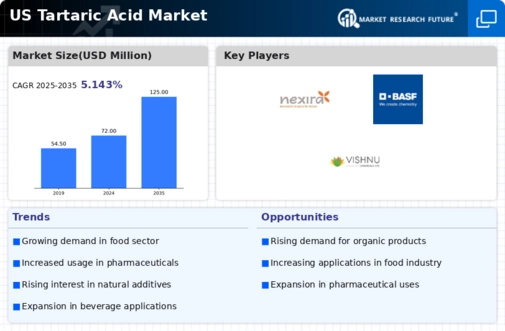The US Tartaric Acid Market has experienced notable growth due to rising demand in food and beverage, pharmaceuticals, and other industries. Tartaric acid, derived from natural sources, is versatile and widely utilized for its stabilizing and acidifying properties. With increasing health awareness, the market has seen a surge in interest for naturally sourced tartaric acid as consumers become drawn to cleaner, more organic products. The competitive landscape of the market is characterized by several key players who are continually innovating to enhance product offerings, expand their market presence, and build stronger brand loyalty among consumers.
Understanding the strategies of leading companies informs stakeholders about opportunities for growth and the challenges that may arise within the sector.Nexira has established a strong presence within the US Tartaric Acid Market, recognized for its commitment to quality and sustainability. The company specializes in producing natural ingredients, including tartaric acid, derived primarily from grape sources. Nexira's strengths lie in its robust supply chain, which emphasizes sustainability while ensuring product consistency and quality. The company's focus on innovation and developing high-performance solutions has set it apart from competitors, making it a reliable partner for various industries looking for natural ingredients.
Nexira's reputation for customer-centric service and technical expertise also adds significant value, enabling it to cater to the specific needs of its clients effectively.BASF has made significant inroads into the US Tartaric Acid Market, leveraging its extensive portfolio that includes key products such as tartaric acid derivatives used in multiple applications, including food and pharmaceuticals. The company's strengths are underscored by its strong research and development capabilities, enabling it to create customized solutions tailored to customer preferences while maintaining high-quality standards.
With strategic mergers and acquisitions, BASF has expanded its operational footprint in the US market, positioning itself as a leading player. This extensive market presence is further enhanced by its commitment to sustainability and innovation, allowing BASF to adapt quickly to changing consumer demands and regulatory requirements in the United States, ensuring that it remains competitive in this dynamic sector.














Leave a Comment